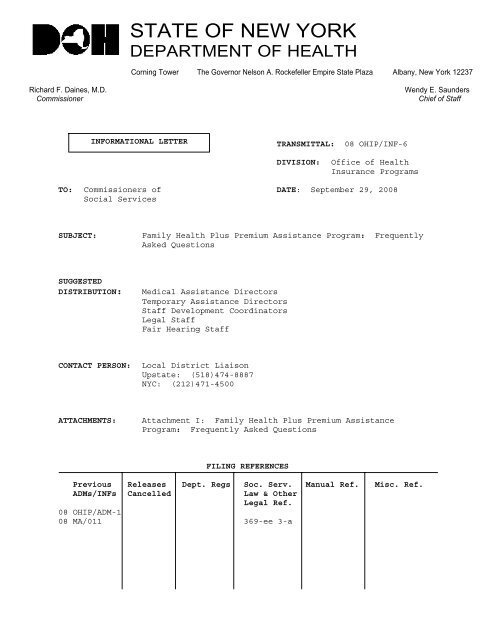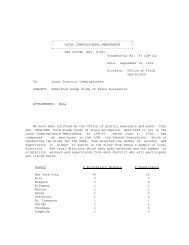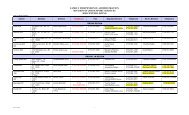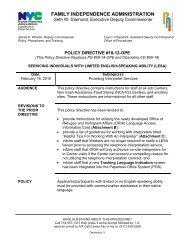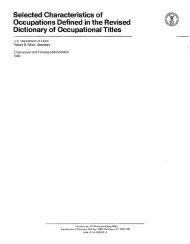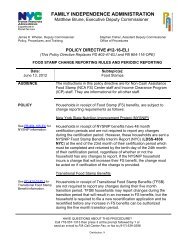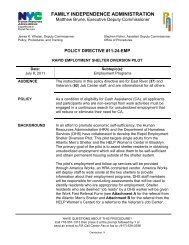Family Health Plus Premium Assistance Program - Online Resource ...
Family Health Plus Premium Assistance Program - Online Resource ...
Family Health Plus Premium Assistance Program - Online Resource ...
Create successful ePaper yourself
Turn your PDF publications into a flip-book with our unique Google optimized e-Paper software.
STATE OF NEW YORK<br />
DEPARTMENT OF HEALTH<br />
Corning Tower The Governor Nelson A. Rockefeller Empire State Plaza Albany, New York 12237<br />
Richard F. Daines, M.D. Wendy E. Saunders<br />
Commissioner Chief of Staff<br />
INFORMATIONAL LETTER<br />
TRANSMITTAL: 08 OHIP/INF-6<br />
DIVISION: Office of <strong>Health</strong><br />
Insurance <strong>Program</strong>s<br />
TO: Commissioners of DATE: September 29, 2008<br />
Social Services<br />
SUBJECT: <strong>Family</strong> <strong>Health</strong> <strong>Plus</strong> <strong>Premium</strong> <strong>Assistance</strong> <strong>Program</strong>: Frequently<br />
Asked Questions<br />
SUGGESTED<br />
DISTRIBUTION: Medical <strong>Assistance</strong> Directors<br />
Temporary <strong>Assistance</strong> Directors<br />
Staff Development Coordinators<br />
Legal Staff<br />
Fair Hearing Staff<br />
CONTACT PERSON: Local District Liaison<br />
Upstate: (518)474-8887<br />
NYC: (212)471-4500<br />
ATTACHMENTS: Attachment I: <strong>Family</strong> <strong>Health</strong> <strong>Plus</strong> <strong>Premium</strong> <strong>Assistance</strong><br />
<strong>Program</strong>: Frequently Asked Questions<br />
FILING REFERENCES<br />
Previous Releases Dept. Regs Soc. Serv. Manual Ref. Misc. Ref.<br />
ADMs/INFs<br />
08 OHIP/ADM-1<br />
Cancelled Law & Other<br />
Legal Ref.<br />
08 MA/011 369-ee 3-a
Date September 29, 2008<br />
Trans. No. 08 OHIP/INF-6 Page No.2<br />
I. Purpose<br />
The purpose of this Informational Letter is to address frequently asked<br />
questions regarding the <strong>Family</strong> <strong>Health</strong> <strong>Plus</strong> <strong>Premium</strong> <strong>Assistance</strong> <strong>Program</strong> (FHP-<br />
PAP).<br />
Deborah Bachrach<br />
Deputy Commissioner<br />
Office of <strong>Health</strong> Insurance <strong>Program</strong>s
Attachment<br />
I. POLICY:<br />
FAMILY HEALTH PLUS PREMIUM ASSISTANCE PROGRAM<br />
(FHP- PAP)<br />
Frequently Asked Questions<br />
1. Q: Are government employees eligible for FHP- PAP?<br />
A: Individuals who are eligible for employer-sponsored health insurance (ESI)<br />
through Federal, State, county, municipal or school district health benefit plans are not<br />
allowed to enroll in <strong>Family</strong> <strong>Health</strong> <strong>Plus</strong>. Therefore, these individuals are not eligible to<br />
participate in the <strong>Family</strong> <strong>Health</strong> <strong>Plus</strong> <strong>Premium</strong> <strong>Assistance</strong> <strong>Program</strong>.<br />
2. Q: Please define what it means to have “access” to employer sponsored<br />
health insurance.<br />
A: An applicant with access to ESI is an individual whose employer offers health<br />
insurance benefits to its employees, and the individual is eligible for those benefits. For<br />
example, an employer may only offer benefits to employees who work full time. In<br />
addition, the ability of the applicant to enroll in those benefits must be reasonable and<br />
uncomplicated. For example, if the employer is not cooperative in providing necessary<br />
plan information to the applicant or to the district, then the district would be unable to<br />
determine if “access” exists.<br />
3. Q: If an FH<strong>Plus</strong> eligible applicant has access to ESI and it is deemed<br />
qualified and cost effective, but the applicant fails to enroll, are there any<br />
consequences?<br />
A: At this time there is no penalty for a FH<strong>Plus</strong> eligible applicant who has access, but<br />
does not enroll in ESI. The goals of the program are to provide participants with a<br />
choice of coverage and provider options. It may make health coverage more convenient<br />
and improve access to care by keeping family members together, under one plan,<br />
rather than having a parent(s) enrolled in ESI or be uninsured, and children enrolled in<br />
Medicaid or CH<strong>Plus</strong>. <strong>Premium</strong> <strong>Assistance</strong> also gives the State potential to save money<br />
by capturing employer contributions towards premiums. By helping low wage workers<br />
to pay for ESI, it may help employers reduce turnover and attract more qualified<br />
employees.<br />
4. Q: Is NYS going to advertise or inform the public of this new program?<br />
A: All FH<strong>Plus</strong> enrollees were sent a letter in December 2007, explaining the program.<br />
A <strong>Family</strong> <strong>Health</strong> <strong>Plus</strong> <strong>Premium</strong> <strong>Assistance</strong> <strong>Program</strong> brochure has been created for the<br />
districts to share with new applicants. It is Attachment A of OHIP 08 ADM-1. In<br />
addition, the Employer Fact Sheet (Attachment B) may be shared with employers.<br />
5. Q: If a FH<strong>Plus</strong> member switches to their employer sponsored health<br />
insurance, what happens to the six month guarantee?<br />
A: There is no loss of eligibility, so there is no need for the six month guarantee.<br />
1
6. Q: If the parents have FHP-PAP, the Medicaid child has coverage code 01,<br />
and the parents lose their ESI, would the child get continuous coverage?<br />
A: There would be no effect on a child if parents lose their ESI, as long as the child<br />
doesn’t lose financial eligibility. If the case loses eligibility, the child would be entitled to<br />
any remaining months of continuous coverage.<br />
7. Q: A recipient is interested in FHP-PAP because she/he has a new job and<br />
will be paying for insurance. The recipient was Medicaid eligible, but with the<br />
income from the new job is FH<strong>Plus</strong> eligible. Do they have to fill out an application<br />
to request the new program?<br />
A: No new application is necessary.<br />
8. Q: Will the Access NY application be changed?<br />
A: A message will be added to the instructions and to Section E of the Access NY<br />
application to say, “We may be able to pay the cost of your health insurance premiums”.<br />
9. Q: Can the Access NY application be changed to tell members not to drop<br />
their commercial insurance when they apply for <strong>Family</strong> <strong>Health</strong> <strong>Plus</strong>?<br />
A: The Applicant Brochure, Attachment A of OHIP 08 ADM-01, used in conjunction<br />
with the application, advises applicants not to drop their commercial insurance. The<br />
employer Fact Sheet, Attachment B, may be shared with employers who then can<br />
educate their employees as to where they can get premium assistance.<br />
10. Q: If a self-employed person has purchased insurance though the Chamber<br />
of Commerce, is this considered Employer Sponsored <strong>Health</strong> Insurance?<br />
A: It is not considered employer sponsored health insurance if the person insured is a<br />
sole proprietor. If the policy covers the proprietor and other employees, then it is<br />
considered employer based.<br />
11. Q: If a person buys insurance through <strong>Health</strong>y NY is this considered ESI?<br />
A: If the <strong>Health</strong>y NY policy is coverage purchased by a small employer, it is ESI. The<br />
policies available through <strong>Health</strong>y NY for sole proprietors and individuals are not<br />
considered ESI.<br />
12. Q: Can COBRA premiums be paid for under the FHP-PAP?<br />
A: No. COBRA is not considered ESI because the employer is not contributing<br />
toward the cost of the premium.<br />
13. Q: Who enrolls the individual in ESI, the individual or the LDSS?<br />
A: The individual enrolls. The individual will have to supply the employer insurance<br />
information to the LDSS, the LDSS may mail the Request For Information Form to the<br />
employer. If the employer fails to return the form, the applicant cannot be penalized.<br />
14. Q: If the employer provides the health insurance information can we enroll<br />
the A/R in the ESI on his or her behalf?<br />
A: No.<br />
2
15. Q: Should we end the FH<strong>Plus</strong> enrollment if we know the individual will be<br />
offered open enrollment through their employer insurance?<br />
A: The FH<strong>Plus</strong> enrollment end date should be coordinated with the start date of ESI.<br />
16. Q: How will the LDSS know the dates of a company’s open enrollment<br />
period?<br />
A: Ask the applicant and/or employer to complete the Employer Sponsored <strong>Health</strong><br />
Insurance Form (Attachment C of OHIP 08 ADM-1).<br />
17. Q: Would there be an overlap of coverage if an individual is enrolled in<br />
FH<strong>Plus</strong> and eligible to be enrolled in ESI?<br />
A: The worker would coordinate closing the FH<strong>Plus</strong> with the enrollment in ESI. The<br />
MA Coverage From Date must be the first day of the month after T+14. If an overlap is<br />
unavoidable, pay the ESI premium and advise the recipient to use the FH<strong>Plus</strong> coverage<br />
during the overlap period.<br />
18. Q: If an individual is FHP-PAP eligible, but the open enrollment period will<br />
not occur for several months into the future, how should the case be processed?<br />
A: Determine eligibility for <strong>Family</strong> <strong>Health</strong> <strong>Plus</strong> without regard to Employer-Sponsored<br />
<strong>Health</strong> Insurance, following existing procedures. If otherwise FH<strong>Plus</strong> eligible, enroll in a<br />
FH<strong>Plus</strong> managed care plan. Advise the applicant to fill out the appropriate ESI<br />
enrollment forms with the employer, to enroll in the employer plan as soon as eligible,<br />
and to provide proof of enrollment to the district. Enter a health insurance Indicator (HII)<br />
of “7”, “FHP-PAP Pending Open Enrollment”, which will alert worker at renewal that<br />
follow-up is needed. Enter the Anticipated Future Action code of 913, “Open enrollment<br />
month for App”, and the anticipated effective date of ESI enrollment in WMS to track<br />
enrollment date, and take necessary action to follow-up with recipient to ensure<br />
enrollment in ESI occurs.<br />
19. Q: What should the district do when the individual is FH<strong>Plus</strong> eligible and<br />
has access to ESI, but it is not deemed qualified or cost effective<br />
A: As long as the FH<strong>Plus</strong> eligible applicant is not enrolled in the ESI, the applicant is<br />
eligible for enrollment in a FH<strong>Plus</strong> managed care plan. At renewal, a re-determination of<br />
cost effectiveness of the ESI may be done as premium costs often change on an annual<br />
basis.<br />
20. Q: If a parent and child(ren) apply and are covered by the absent parent’s<br />
employer insurance, can the parent be FHP-PAP eligible?<br />
A: Yes, as long as the parent can provide enough information about the policy to<br />
determine if it is deemed qualified. It will likely be cost effective, because she/he pays<br />
none of the premium.<br />
21. Q: Can boyfriend, girlfriend and common child all be on the same case if<br />
one person is FHP-PAP?<br />
A: Yes.<br />
22. Q: Can a child in the household be Mehlered out to determine eligibility for<br />
the remaining family members?<br />
A: Yes. In the cost effective calculation do not include that child in the household<br />
count.<br />
3
23. Q: If the district discovers third party health insurance has been posted in<br />
eMedNY by HMS, (the State’s third party contractor), should the recipient be<br />
disenrolled from FH<strong>Plus</strong> while a FHP-PAP determination is made?<br />
A: Mail the “Employer Sponsored <strong>Health</strong> Insurance: Request for Information” form<br />
(Attachment C of 08 OHIP ADM -1) to the recipient, giving the recipient 10 days to<br />
complete. If the form is returned, complete the cost effectiveness calculation. If it is<br />
cost effective to pay the health insurance premiums, disenroll the recipient from FH<strong>Plus</strong><br />
and pay the ESI premiums prospectively. If not cost effective, send a closing notice to<br />
the recipient citing equivalent health insurance. If the form is not returned, disenroll the<br />
recipient from FH<strong>Plus</strong> citing equivalent health insurance.<br />
24. Q: If a recipient is enrolled in a FH<strong>Plus</strong> managed care plan and it is<br />
discovered she/he is also enrolled in that same plan through her/his employer,<br />
what are the steps for switching the case to FHP-PAP?<br />
A: Individuals may be retroactively disenrolled from their MMC or FH<strong>Plus</strong> plan when<br />
they are simultaneously in receipt of comprehensive health care from the same MCO.<br />
As soon as you find out someone on FH<strong>Plus</strong> has duplicate insurance, do the cost<br />
effective/benchmark plan determination. If qualified and cost effective, move the<br />
individual(s) into FHP-PAP and retroactively disenroll the recipient from managed care,<br />
collecting any premiums using our current criteria, and pay the ESI premiums<br />
prospectively. If it is not qualified and cost effective, then retroactively disenroll the<br />
recipient per current procedure.<br />
25. Q: How long may the recipient continue to receive benefits under coverage<br />
code 20 after they no longer are enrolled in the ESI?<br />
A: Send OHIP 0011, Notice of Decision for <strong>Family</strong> <strong>Health</strong> <strong>Plus</strong> – <strong>Premium</strong> <strong>Assistance</strong><br />
<strong>Program</strong> to Discontinue. It gives the recipient 10 days to respond and choose a health<br />
plan or be closed. If the plan choice is returned, benefits under coverage code 20 may<br />
be provided until the enrollment in the FH<strong>Plus</strong> plan begins. We encourage FHP-PAP<br />
recipients to choose a health plan at the time of application in case this scenario occurs.<br />
26. Q: When a recipient loses their ESI, and there is no managed care plan<br />
choice in the case record, or the plan choice is old or obsolete, can the recipient<br />
be auto-assigned into a FH<strong>Plus</strong> plan?<br />
A: Auto-assignment into FH<strong>Plus</strong> will be available in undercare situations when<br />
system support is established. System support is anticipated to be available by<br />
February 2009. Additional information will be forthcoming. However, at this time, if the<br />
district has only one <strong>Family</strong> <strong>Health</strong> <strong>Plus</strong> plan available, the individual can be auto<br />
enrolled into that plan.<br />
27. Q: A household consists of FH<strong>Plus</strong> eligible parents and children over age 6.<br />
The parents have access to an ESI policy that would cover the entire family. If the<br />
cost of the health insurance premium is given as an income deduction in the<br />
budget, the children are expanded eligible. If it is not in budget (and will be paid<br />
through the FHP <strong>Premium</strong> <strong>Assistance</strong> <strong>Program</strong>), the children are ineligible. What<br />
would be the best budget for the family in this situation?<br />
A: The family should decide based on the medical needs of family members. If the<br />
premium is allowed as an income deduction (the parents continue to pay the premium),<br />
the children would be expanded eligible, receive commercial insurance coverage and<br />
get Medicaid fee-for-service. The parents would utilize the commercial insurance.<br />
4
If the premium is paid by FHP-PAP, the children would utilize the commercial insurance,<br />
and the parents would be enrolled in FHP-PAP, which includes the services covered by<br />
the commercial insurance and wrap around benefits.<br />
II. Employer Sponsored <strong>Health</strong> Insurance Form: Request for Information<br />
(Attachment C of OHIP ADM-1):<br />
28. Q: If a recipient does not provide third party health insurance information<br />
from the employer, can we contact the employer for the information?<br />
A: Yes, send the employer an ESI form. The applicant cannot be penalized if the<br />
employer does not return the form.<br />
29. Q: Is it a condition of eligibility for the applicant to return the Employer<br />
Sponsored <strong>Health</strong> Insurance forms?<br />
A: If the applicant indicates on the application that she/he is in receipt of employer<br />
sponsored health insurance, and the applicant is otherwise FH<strong>Plus</strong> eligible, the<br />
applicant or the employer must complete the ESI form. If the applicant is not enrolled in<br />
ESI and does not return the form, the applicant is not penalized at this time.<br />
30. Q: When the LDSS knows an employer offers health insurance and the<br />
applicant indicates otherwise, is it okay for the LDSS to investigate this further?<br />
A: Give the applicant the third party health insurance form to bring to their employer or<br />
mail the form to the employer.<br />
III. COST EFFECTIVENESS:<br />
31. Q: Is the cost effective calculation used for FHP-PAP the same as the<br />
calculation used for Medicaid cases?<br />
A: The calculations are different. The cost effectiveness tool for FHP-PAP should<br />
only be used for FHP-PAP cases. Counties should continue to use the Medicaid cost<br />
effectiveness method for Medicaid cases.<br />
32. Q: When a family is no longer FH<strong>Plus</strong> eligible but becomes Medicaid<br />
eligible, should a different cost effective determination be done to see if the ESI<br />
premiums should continue to be paid and if no longer considered cost effective,<br />
then terminate the payment and switch to Medicaid or Medicaid Managed Care?<br />
A: The current methodology for determining cost effectiveness should be used on<br />
Medicaid cases, not the FHP-PAP method. If a Medicaid recipient/family has ESI and it<br />
is cost effective under Medicaid rules, the premium should be paid and the ESI should<br />
be entered in eMedNY. If the recipient/family is not eligible for managed care, they<br />
would get fee-for-service Medicaid per current rules.<br />
33. Q: If a FH<strong>Plus</strong> eligible married couple applies and only one spouse is<br />
offered insurance, would that person be FHP-PAP and the other spouse remain in<br />
FH<strong>Plus</strong>?<br />
A: Yes, if only single coverage is offered, one spouse can be eligible for FHP-PAP<br />
and the other for FH<strong>Plus</strong>.<br />
34. Q: If someone is enrolled in ESI, but is not required to pay or contribute<br />
towards the premium, can they be eligible for FHP-PAP?<br />
5
A: Yes, although they have no premium payment, they can benefit from the copayments<br />
and deductibles being reimbursed to them. The plan must also be deemed<br />
qualified.<br />
35. Q: In Section (a) of the FHP-PAP Cost Effective Calculator, question #2:<br />
“Does the employer policy include the Optional/Non-Benchmark required<br />
services listed in Column A, lines 2a through 2e?” If the answer is "No", there are<br />
instructions on how to proceed; however, there are no instructions for the "YES"<br />
option. Does one skip to Section B? What is the next logical step?<br />
A: If "no" the regional cost of the service is added to the cost of the ESI and<br />
compared to the FH<strong>Plus</strong> managed care rate. If the answer is “Yes”, the plan does cover<br />
the optional benefits, do not enter a cost. Skip to section B.<br />
36. Q: When the family includes FH<strong>Plus</strong> eligible parents and non-Medicaid<br />
children over the age of 6, should the children be included in the FHP-PAP cost<br />
effectiveness calculation?<br />
A: No, the children would not be included in the case count, but you would use the<br />
family premium to see if it is cost effective to pay the family premium. If not cost<br />
effective to pay the family premium, then do a cost effectiveness for just the parents, if<br />
the premium is different for the parents.<br />
37. Q: If non-Medicaid eligible children are on the family policy, will Medicaid<br />
pay the deductibles, coinsurance and co-pays for the children?<br />
A: The parents would pay the children’s deductibles and co-pays. They would not be<br />
reimbursed for costs associated with non-Medicaid eligible children.<br />
38. Q: What should the district do if it is determined cost effective to pay the<br />
family plan insurance and the children are on CH<strong>Plus</strong>?<br />
A: If the children are enrolled in the ESI policy, the district should notify the CH<strong>Plus</strong><br />
plan of the child’s insurance.<br />
39. Q: If there are CH<strong>Plus</strong> children in the household, should they be considered<br />
when doing the cost effective calculation?<br />
A: Only costs for expanded Medicaid eligible children and FH<strong>Plus</strong> adults should be<br />
included in the FHP-PAP cost effective determination. If it is cost effective to pay for a<br />
family policy, CH<strong>Plus</strong> eligible children can be added to the ESI policy.<br />
40. Q: If a household contains FH<strong>Plus</strong> eligible parents and CH<strong>Plus</strong> eligible<br />
children, should the children enroll in the ESI?<br />
A: If the policy is a family policy (not just a “couples” policy) and it is cost effective,<br />
the district should encourage the parents to enroll the children in that policy. The district<br />
should notify the CH<strong>Plus</strong> plan of this enrollment.<br />
41. Q: Will the parents be reimbursed for coinsurance, deductibles or copayments<br />
made on behalf of the CH<strong>Plus</strong> children?<br />
A: The parents will not be reimbursed for those costs.<br />
42. Q: Can the parents refuse to enroll the children in ESI in order to avoid<br />
paying coinsurance, deductibles and co-payments?<br />
A: We cannot force non-applying children to be added to the policy. If the children are<br />
enrolled in the ESI, the CH<strong>Plus</strong> plan should be notified. The districts may call the<br />
6
CH<strong>Plus</strong> managed care plan or send proof of insurance coverage, such as a copy of the<br />
insurance card.<br />
43. Q: If a recipient uses an Article 28 dental clinic for dental wrap around<br />
benefits do we use that in the calculations?<br />
A: If an individual used an Article 28 dental clinic, we would cover it. The cost<br />
effective calculator will not use the Article 28 dental clinic rate. We cannot assume<br />
everyone will use a dental clinic.<br />
IV. PAYMENTS:<br />
44. Q: Which services are subject to FH<strong>Plus</strong> co-pays?<br />
A: Per 05 OMM/ADM-4, effective September 1, 2005, <strong>Family</strong> <strong>Health</strong> <strong>Plus</strong> enrollees<br />
will be responsible for the following co-payments:<br />
Brand name prescription drugs $6 for each prescription and refill<br />
Generic prescription drugs $3 for each prescription and refill<br />
Clinic visits $5 per visit<br />
Physician visits $5 per visit<br />
Dental service visits $5 per visit up to a total of $25 per year<br />
Lab tests $0.50 per test<br />
Radiology services (e.g., diagnostic xrays,<br />
ultra- sound, nuclear medicine,<br />
and oncology services)<br />
$1 per radiology service<br />
Inpatient hospital stay $25 per stay<br />
Non-urgent emergency room visit $3 per visit<br />
Covered over-the-counter drugs (e.g.,<br />
smoking cessation products; insulin)<br />
$0.50 per medication<br />
Covered medical supplies (e.g.,<br />
diabetic supplies such as syringes,<br />
lancets, test strips, enteral formula)<br />
$1 per supply<br />
Co-payments will not be applied to the following services:<br />
• Emergency services<br />
• <strong>Family</strong> planning services and supplies<br />
• Mental health clinics<br />
• Chemical dependence clinics<br />
• Psychotropic drugs<br />
• Tuberculosis drugs<br />
• Prescription drugs for a resident of an Adult Care Facility licensed by the State<br />
Department of <strong>Health</strong><br />
Similar to the policy for Medicaid, the following people are exempt from making copays:<br />
pregnant women; individuals under age 21; permanent residents of nursing<br />
homes; and residents of community-based residential facilities licensed by the Office of<br />
Mental <strong>Health</strong> or Office of Mental Retardation and Developmental Disabilities. If a<br />
<strong>Family</strong> <strong>Health</strong> <strong>Plus</strong> enrollee cannot afford the co-payment at the time of the service, the<br />
provider cannot refuse to provide the care or service.<br />
7
Other than the $25 annual cap for co-payments on dental services, <strong>Family</strong> <strong>Health</strong><br />
<strong>Plus</strong> has no other cap on co-payments. <strong>Family</strong> <strong>Health</strong> <strong>Plus</strong> plans will be responsible for<br />
the implementation of applicable co-payments and tracking the annual dental cap.<br />
The FH<strong>Plus</strong> recipient should be reimbursed the difference between the co-pay<br />
paid and the FH<strong>Plus</strong> co-payment schedule amounts. If there is a co-pay for a service<br />
for which there is no corresponding FH<strong>Plus</strong> co-pay, we would reimburse the whole<br />
amount.<br />
Vision Benefits<br />
Currently, the <strong>Family</strong> <strong>Health</strong> <strong>Plus</strong> vision benefit is similar to the Medicaid vision benefit.<br />
The <strong>Family</strong> <strong>Health</strong> <strong>Plus</strong> vision benefit will cover the following once every 2 years: 1) one<br />
eye exam; 2) either one pair of prescription eyeglass lenses and a frame, or prescription<br />
contact lenses where medically necessary; and 3) one pair of medically necessary<br />
occupational eyeglasses. Lost eyeglasses are no longer a covered benefit.<br />
45. Q: What is the difference between coinsurance and co-payment?<br />
A: Having a health plan that includes a coinsurance, or percentage participation rate,<br />
means that the member and insurance carrier each pay a specified percentage of the<br />
healthcare cost.<br />
For instance, if the health plan has an 80/20 coinsurance rate, the insurance plan pays<br />
for 80% of the eligible medical expense and the member is responsible for the<br />
remaining 20%. A co-payment, on the other hand, is a fixed dollar amount ($5.00 for<br />
example) that the member is required to pay regardless of the cost of the service<br />
received.<br />
To compensate for the possibility that a catastrophic medical loss could cause a<br />
member severe financial distress, many major health insurance carriers include what is<br />
known as a “coinsurance cap”, or stop-loss limit in their plans. The provision sets limits<br />
on the member’s potential out-of-pocket costs per year. Such caps generally range from<br />
$2,000 to $3,000, depending on the plan, but limits can be as low as $1,000.<br />
46. Q: Who will the district pay the premium payments to?<br />
A: <strong>Premium</strong> payments can be made to the applicant, the employer or the carrier as<br />
arranged with the payee. Per 08 OHIP/ADM-1, Upstate district are instructed to make<br />
payments via the Benefit Issue Control System (BICS).<br />
47. Q: Who is responsible to pay the co-pays, coinsurance and deductibles?<br />
A: The recipient pays the co-payments, coinsurance and deductibles and brings the<br />
receipt into LDSS for reimbursement.<br />
48. Q: Can an individual with FHP-PAP refuse to pay a co-pay, for example at<br />
the pharmacy, and still receive their prescription?<br />
A: If the recipient is using the New York State Benefit Identification card (because<br />
drugs are not included in the ESI) to obtain prescriptions, the recipient may refuse to<br />
pay the co-pay per current Medicaid rules. If the individual is using the ESI commercial<br />
insurance card, she/he may not refuse to pay the co-pay. The district will reimburse the<br />
recipient for the co-pay paid minus the FH<strong>Plus</strong> co-pay amount.<br />
8
49. Q: Is there a hardship provision if the member says they cannot pay the copays<br />
and deductibles up front for services?<br />
A: There is no hardship provision in the FHP-PAP legislation.<br />
50. Q: When the commercial policy has a co-payment that is greater than the<br />
FH<strong>Plus</strong> co-payment, how much should the district reimburse the member?<br />
A: The member pays the ESI co-payment to the provider. The district reimburses the<br />
member the ESI co-pay amount minus any applicable FH<strong>Plus</strong> co-pay amount.<br />
51. Q: If a member requests cash to pay a co-pay prior to seeing a provider<br />
should the district authorize payment prior to the appointment?<br />
A: No, only paid receipts may be submitted to the district for reimbursement.<br />
52. Q: Will this program reimburse coinsurance, deductibles, and/or co-pays for<br />
benefits which are not provided by FH<strong>Plus</strong> even though they are provided by the<br />
ESI?<br />
A: No. We will not pay or reimburse for a service not otherwise covered by <strong>Family</strong><br />
<strong>Health</strong> <strong>Plus</strong>.<br />
53. Q: If a member goes out of network for a service that is provided under the<br />
employer’s plan (it is also a service covered under FH<strong>Plus</strong>), and the member pays<br />
cash for it, can the district deny reimbursement because the member went out of<br />
network?<br />
A: The member may be reimbursed, but must present an Explanation of Benefits<br />
(EOB) from the plan showing the amount the plan paid towards the claim. The<br />
reimbursement would equal the amount which would not be paid by the plan minus the<br />
FH<strong>Plus</strong> co-payment.<br />
54. Q: If a member goes for a non-FH<strong>Plus</strong> benefit, such as chiropractor, is the<br />
member entitled to reimbursement for a co-payment paid?<br />
A: No. We will not pay or reimburse for a service not otherwise covered by <strong>Family</strong><br />
<strong>Health</strong> <strong>Plus</strong>.<br />
55. Q: Is reimbursement required to a recipient who does not use their own ESI<br />
provider, or a Medicaid provider? Or will it be a patient "out of pocket" expense?<br />
Is Payment Type code U4 used in this instance? At what rate is the claim<br />
reimbursed?<br />
A: There may be times when a service is not covered under the employer's policy<br />
and the recipient used a non-Medicaid provider for a benefit that would otherwise be<br />
covered by FH<strong>Plus</strong>. The recipient would have to provide the LDSS with an Explanation<br />
of Benefits (EOB) showing the claim was denied by the employer plan. In these<br />
instances the recipient can be reimbursed for payment made, minus the FH<strong>Plus</strong> copayment<br />
amount for the service. U4 is the BICS pay type to be used.<br />
56. Q: Can the district tell the recipient they have a limited time to bring in<br />
receipts for reimbursement?<br />
A: No. However, recipient education is key. Advise them to bring in receipts in a<br />
timely manner. Local districts are also required to process reimbursements in a timely<br />
manner.<br />
9
57. Q: If a case is closed due to failure to recertify, who should notify the<br />
employer or Insurance Company that the district will no longer pay the premium?<br />
A: The district should notify the employer or insurance company that premium<br />
payments will be discontinued.<br />
58. Q: If the cost of the premium for the employer's dental coverage is more<br />
than the regional wrap around rate, should the recipient enroll and pay for it?<br />
After completing a cost effectiveness determination, it was found that the total<br />
cost of insurance (including dental) added in through either the employer or the<br />
wrap is still less than the FH<strong>Plus</strong> monthly premium.<br />
A: Since cost of the dental is less than the total cost of the FH<strong>Plus</strong> monthly premium,<br />
give the recipient the choice whether it is paid through the recipient’s premium or added<br />
to the wrap. The recipient may want the private policy because there may be more<br />
providers available than there are Medicaid providers. The recipient can choose not to<br />
enroll and get it through Medicaid.<br />
59. Q: Is there a letter that goes out with the payments that are authorized in<br />
screen 6?<br />
A: BICS does not produce the letters. The Manual Notice of Decision for FHP-PAP<br />
may be used to notify recipients of the decision, premium amount to be reimbursed and<br />
frequency of those payments.<br />
60. Q: If the recipient notifies the district of their enrollment in a qualified, cost<br />
effective ESI several months after they actually enrolled (but were in receipt of<br />
FH<strong>Plus</strong> during this time), should the district reimburse the premium (co-pay,<br />
coinsurance, deductibles) for the months prior to the notification? Or should the<br />
reimbursement start with the month they notify the district?"<br />
A: Prospective ESI premiums can be reimbursed for months following disenrollment<br />
from FH<strong>Plus</strong> MC. Under FHP-PAP, the disenrollment from FH<strong>Plus</strong> is supposed to be<br />
coordinated with the enrollment in ESI, so that there is no overlap. Also refer to<br />
questions number 23 and 24.<br />
V. WRAP:<br />
61. Q: What will the wrap around benefit cover?<br />
A: Wrap around benefits will be provided on a fee-for-service basis for benefits<br />
provided by a FH<strong>Plus</strong> plan, but are not covered by the individual’s ESI.<br />
62. Q: Can the district request the member go to a Medicaid provider to pay for<br />
the wrap around services?<br />
A: Yes.<br />
63. Q: If there are no Medicaid providers available to provide wrap around<br />
services, can the recipient use a non-Medicaid provider?<br />
A: The local districts are directed in the ADM to advise recipients to use Medicaid<br />
providers for wrap services. This is an easement for the districts, since these claims<br />
can be billed directly through eMedNY. A recipient using a non-Medicaid provider may<br />
still be reimbursed via the manual process by the districts. A BICS pay type (Upstate)<br />
of "other" has been created for these situations. This is explained in the BICS portion of<br />
the ADM.<br />
10
64. Q: What insurance cards would the member have and what order should<br />
they use them in?<br />
A: The recipient would have a commercial insurance card from the ESI plan and a<br />
New York State Benefit Identification card for wrap around benefits. Both cards should<br />
be presented to the provider. The provider should always bill the commercial insurance<br />
plan first, and then bill Medicaid.<br />
65. Q: Individuals will need a Benefit card to access wrap around services. Will<br />
they require a photo ID?<br />
A: FH<strong>Plus</strong> eligibles are not required to have a photo ID.<br />
66. Q: If the FH<strong>Plus</strong> plans in our district do not cover dental, will FHP-PAP<br />
enrollees get dental coverage?<br />
A: Yes, the wrap will cover dental. The recipient will use the Benefit card.<br />
67. Q: If a FHP-PAP person has ESI, that does not cover dental, do they get the<br />
benefit of dental with the wrap?<br />
A: Yes.<br />
68. Q: We do not have any providers in our district that accept Medicaid. If we<br />
reimburse the recipient for dental expenses, what type of services do we<br />
reimburse, and how do we determine how much to reimburse?<br />
A: Dental care includes preventive, prophylactic, and other routine dental care,<br />
services, supplies and dental prosthetics required to alleviate a serous health condition,<br />
including one which affects employability. Orthodontic services are not covered.<br />
Reimburse what the member paid minus the FH<strong>Plus</strong> co-pay.<br />
69. Q: Is Medical Transportation part of the wrap around service?<br />
A: FH<strong>Plus</strong> members are not eligible for non-emergency transportation. Most<br />
commercial insurances cover emergency transportation. If the commercial insurance<br />
does not provide coverage for emergency transportation, the wrap around coverage will.<br />
70. Q: If an employer plan covers the same service as FH<strong>Plus</strong> (e.g., outpatient<br />
mental health counseling), but the number of covered visits is less than what a<br />
FH<strong>Plus</strong> plan would allow, can the recipient be reimbursed for visits in excess of<br />
what the ESI plan allows?<br />
A: Yes. The recipient would be reimbursed for visits in excess of what the ESI would<br />
cover up to the FH<strong>Plus</strong> limit of 60 visits.<br />
71. Q: If an employer plan covers eye exams but not lenses or frames, should<br />
the cost of vision care be added to Section A of the cost effectiveness calculator?<br />
A: Since this plan only covers eye exams, it does not meet the standard for vision<br />
care. It should be added to the wrap. It also should not be entered as a commercial<br />
benefit on eMedNY. However, remind the recipient to present his commercial insurance<br />
card first so any covered services can be paid by the ESI.<br />
11
VI. WMS:<br />
72. Q: What <strong>Health</strong> Insurance Indicator (HII) code should be used when<br />
registering or opening a FHP-PAP case?<br />
A: HII code 09 may be used. This code may be removed at the time of renewal as it<br />
is not required on 05 and 06 transactions.<br />
73. Q: Should a special claiming code be used for FHP-PAP?<br />
A: On page 12 of the ADM, under the heading of Systems Implications, BICS pay<br />
types are discussed. The ADM states that “no special claiming code should be used”.<br />
This information has changed. Workers should enter a special claiming code of “V”,<br />
which means “all other FP” when using pay types U1 through U5. Additional<br />
information about claiming codes is outlined in the January 30, 2008 WMS<br />
Coordinator’s letter.<br />
74. Q: The new Pay Type U1 will not allow the use of 03 (vendor as billed). Can<br />
that be added? Or can we continue to use the pay type 24?<br />
A: Pay type U1 is for a FHP-PAP premium payment. The districts should use Method<br />
of Payment 01 or 02, which require an amount on the pay line. Method of Payment 03<br />
is not used because if the vendor/recipient were to bill for an increased premium<br />
amount, it would automatically get paid by the district. The districts should instead<br />
complete a new cost effectiveness determination when a premium amount has<br />
changed. Pay type 24 should never be used with a FHP-PAP case.<br />
75. Q: How will the EPI code system generate a disenrollment from FH<strong>Plus</strong>?<br />
A: When an individual notifies you they have enrolled in ESI, you will change the<br />
coverage code to 20 and the EPI code to A in WMS. This will system generate a<br />
FH<strong>Plus</strong> disenrollment in T+14 days.<br />
76. Q: When LDSS does reimbursements, payment will be made on BICS. Does<br />
LDSS have the option of sending a transmittal with information to the State for<br />
reimbursement as is done for some of the other reimbursements, e.g., court<br />
cases like Krieger vs. Perales?<br />
A: No. All claiming for the FHP-PAP should be done on line 18 of Schedule E.<br />
VII. EMEDNY:<br />
77. Q: Does the district enter the employer sponsored insurance into eMedNY?<br />
A: Yes, you would enter the commercial insurance in the Third Party screens in<br />
eMedNY, just like any other commercial insurance. Be sure to check off all the benefits<br />
that the plan covers.<br />
VIII. Facilitated Enrollment:<br />
78. Q: What is the FE’s role in this program?<br />
A: The FE should ask the applicants if they have or can get ESI. If the applicant has<br />
other health insurance, the FE should instruct them not to drop it as Medicaid may be<br />
able to pay the cost of the premiums. The applicant should be given the Employer<br />
Sponsored <strong>Health</strong> Insurance form to fill out.<br />
12
79. Q: Should the FE hold the application until the insurance information form<br />
is returned?<br />
A: Do not hold up the application for the insurance form if the applicant is not already<br />
enrolled in ESI. If the applicant is currently enrolled in other health insurance, the form<br />
should be included with the application. If it is not, the local district must follow up with<br />
the information received.<br />
80. Q: Can applications be taken by an FE when a person is already enrolled in<br />
ESI?<br />
A: Yes, as the applicant may be eligible for the <strong>Premium</strong> <strong>Assistance</strong> <strong>Program</strong>.<br />
81. Q: If an applicant is enrolled in ESI or has access to it, should the FE make<br />
sure the applicant fills out the FH<strong>Plus</strong> managed care selection form?<br />
A: Yes, if the applicant is eligible for FH<strong>Plus</strong> and has access to ESI, the applicant will<br />
be enrolled in a FH<strong>Plus</strong> plan until the individual can be enrolled in the employer<br />
insurance. Even if an applicant is already enrolled in ESI, she/he may later lose ESI,<br />
but remain otherwise eligible for FH<strong>Plus</strong>. In this situation, the recipient can be more<br />
efficiently enrolled in FH<strong>Plus</strong> if a plan choice is on record.<br />
13


